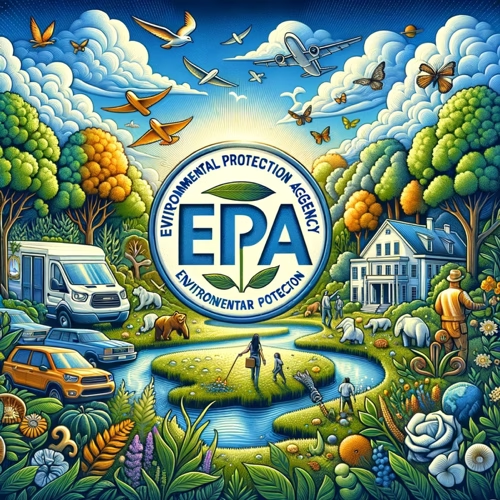Bra podd
Sveriges mest populära poddar

Environmental Protection Agency (EPA) News
EPA Bolsters Drinking Water Standards, Reforms Regulations for Public Health and Environmental Protection
4 min • 19 maj 2025
Welcome to The EnviroMinute, where we break down the week’s biggest stories from the Environmental Protection Agency. It’s Monday, May 19, 2025, and the top headline: the EPA is holding firm on its drinking water standards for two major “forever chemicals”—PFOA and PFOS—reaffirming strict maximum contaminant levels nationwide. This decision signals the agency’s ongoing commitment to public health protection amid widespread concerns about PFAS contamination in water supplies. EPA Administrator Lee Zeldin stated, “We are prioritizing science and the right to clean air, land, and water for every community—no exceptions.” This news comes as the agency outlines a slate of actions to address PFAS, emphasizing science-driven regulation, cross-agency partnership, and community engagement to support those most affected.
Another headline: the EPA has just announced a new phase in its effort to better integrate scientific expertise across all agency offices. This organizational shift is designed to make regulatory decisions more responsive and data-driven, supporting pillars like permitting reform and cooperative federalism. For Americans, this means faster, more evidence-based protection measures—while businesses and local governments get clearer guidance and improved partnership opportunities.
On the regulatory front, the EPA has finalized its Insecticide Strategy, introducing a three-step framework for reviewing pesticide applications. The new approach emphasizes environmental safety, transparent data use, and targeted mitigation, aiming to safeguard pollinators and aquatic habitats. If you use pesticide products or work in agriculture, this means more predictable reviews and a heightened focus on ecological risks.
Enforcement action also made the news: Cytonix, LLC agreed to a $190,525 penalty for violations related to new chemical substances. The company neither admitted nor denied the allegations, but this underscores EPA’s continued monitoring of chemical safety—reassuring consumers and signaling to industry that compliance remains non-negotiable.
There are also several extended comment periods for new Clean Air Act rules, including proposals that target emissions from chemical manufacturing, especially ethylene oxide. If air quality in your area is a concern, now’s the time to participate in the public process, as the EPA is actively seeking public input on both air toxics and greenhouse gas reporting deadlines.
Looking at broader impacts: these moves provide immediate public health protections, regulatory certainty for businesses, and collaborative opportunities for state and local governments. International partners are watching closely—especially as the U.S. refines its approach to water safety, climate policy, and environmental standards.
Expert voices like environmental law analysts note that these actions “strike a balance between robust oversight and practical flexibility.” For citizens, it’s a chance to engage: comment windows are open now for several EPA proposals. Head to epa.gov for details on upcoming hearings and how to submit your views.
That’s our recap. Watch for EPA’s next updates on drinking water protections, air quality rules, and science integration efforts in the coming weeks—and don’t forget to make your voice heard. For full details or to participate, visit epa.gov or your local environmental agency. Stay informed, stay engaged, and thanks for listening to The EnviroMinute.
Another headline: the EPA has just announced a new phase in its effort to better integrate scientific expertise across all agency offices. This organizational shift is designed to make regulatory decisions more responsive and data-driven, supporting pillars like permitting reform and cooperative federalism. For Americans, this means faster, more evidence-based protection measures—while businesses and local governments get clearer guidance and improved partnership opportunities.
On the regulatory front, the EPA has finalized its Insecticide Strategy, introducing a three-step framework for reviewing pesticide applications. The new approach emphasizes environmental safety, transparent data use, and targeted mitigation, aiming to safeguard pollinators and aquatic habitats. If you use pesticide products or work in agriculture, this means more predictable reviews and a heightened focus on ecological risks.
Enforcement action also made the news: Cytonix, LLC agreed to a $190,525 penalty for violations related to new chemical substances. The company neither admitted nor denied the allegations, but this underscores EPA’s continued monitoring of chemical safety—reassuring consumers and signaling to industry that compliance remains non-negotiable.
There are also several extended comment periods for new Clean Air Act rules, including proposals that target emissions from chemical manufacturing, especially ethylene oxide. If air quality in your area is a concern, now’s the time to participate in the public process, as the EPA is actively seeking public input on both air toxics and greenhouse gas reporting deadlines.
Looking at broader impacts: these moves provide immediate public health protections, regulatory certainty for businesses, and collaborative opportunities for state and local governments. International partners are watching closely—especially as the U.S. refines its approach to water safety, climate policy, and environmental standards.
Expert voices like environmental law analysts note that these actions “strike a balance between robust oversight and practical flexibility.” For citizens, it’s a chance to engage: comment windows are open now for several EPA proposals. Head to epa.gov for details on upcoming hearings and how to submit your views.
That’s our recap. Watch for EPA’s next updates on drinking water protections, air quality rules, and science integration efforts in the coming weeks—and don’t forget to make your voice heard. For full details or to participate, visit epa.gov or your local environmental agency. Stay informed, stay engaged, and thanks for listening to The EnviroMinute.
Senaste avsnitt
00:00 -00:00